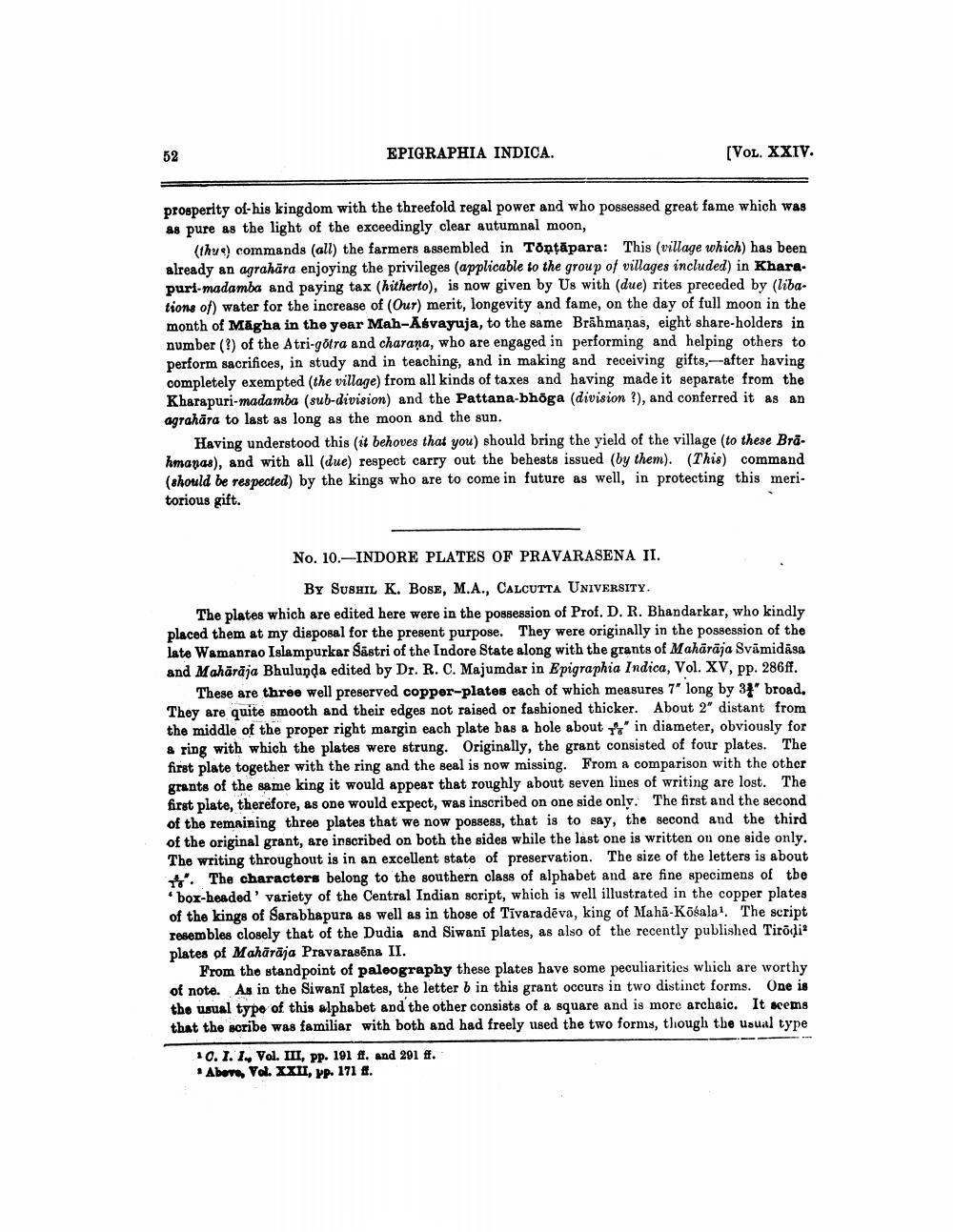________________
52
EPIGRAPHIA INDICA.
(VOL. XXIV.
prosperity of his kingdom with the threefold regal power and who possessed great fame which was as pure as the light of the exceedingly clear autumnal moon,
(thue) commands (all) the farmers assembled in Toptāpara: This (village which) has been already an agrahāra enjoying the privileges (applicable to the group of villages included) in Khara. puri-madamba and paying tax (hitherto), is now given by Us with (due) rites preceded by (libations of water for the increase of (Our) merit, longevity and fame, on the day of full moon in the month of Māgha in the year Mah-Asvayuja, to the same Brāhmaṇas, eight share-holders in number () of the Atri-götra and charana, who are engaged in performing and helping others to perform sacrifices, in study and in teaching, and in making and receiving gifts,--after having completely exempted (the village) from all kinds of taxes and having made it separate from the Kharapuri-madamba (sub-division) and the Pattana-bhoga (division ?), and conferred it as an agrahāra to last as long as the moon and the sun.
Having understood this (it behoves that you) should bring the yield of the village (to these Brähmanas), and with all (due) respect carry out the behests issued by them). (This) command (should be respected) by the kings who are to come in future as well, in protecting this meri. torious gift.
No. 10.-INDORE PLATES OF PRAVARASENA II.
BY SUSHIL K. BOSE, M.A., Calcutta UNIVERSITY. The plates which are edited here were in the possession of Prof. D. R. Bhandarkar, who kindly placed them at my disposal for the present purpose. They were originally in the possession of the late Wamanrao Islampurkar Sastri of the Indore State along with the grants of Mahārāja Svámidasa and Mahārāja Bhulunda edited by Dr. R. C. Majumdar in Epigraphia Indica, Vol. XV, pp. 286ff.
These are three well preserved copper-plates each of which measures 7" long by 34 broad. They are quite smooth and their edges not raised or fashioned thicker. About 2" distant from the middle of the proper right margin each plate bas a hole about to in diameter, obviously for a ring with which the plates were strung. Originally, the grant consisted of four plates. The first plate together with the ring and the seal is now missing. From a comparison with the other grants of the same king it would appear that roughly about seven lines of writing are lost. The first plate, therefore, as one would expect, was inscribed on one side only. The first and the second of the remaining three plates that we now possess, that is to say, the second and the third of the original grant, are inscribed on both the sides while the last one is written on one side only. The writing throughout is in an excellent state of preservation. The size of the letters is about *. The characters belong to the southern class of alphabet and are fine specimens of tbe "box-headed' variety of the Central Indian script, which is well illustrated in the copper plates of the kings of Sarabhapura as well as in those of Tivaradēva, king of Maha-Kõsalal. The script resembles closely that of the Dudia and Siwani plates, as also of the recently published Tirodi plates of Mahārāja Pravarasēna II.
From the standpoint of paleography these plates have some peculiarities which are worthy of note. As in the Siwani plates, the letter b in this grant occurs in two distinct forms. One is the usual type of this alphabet and the other consists of a square and is more archaic. It seems that the scribe was familiar with both and had freely used the two forms, though the usual type
10.1.1., Vol. III, pp. 191 ff. and 291 ff.
Abon, Vol. XXII, pp. 171 f.




